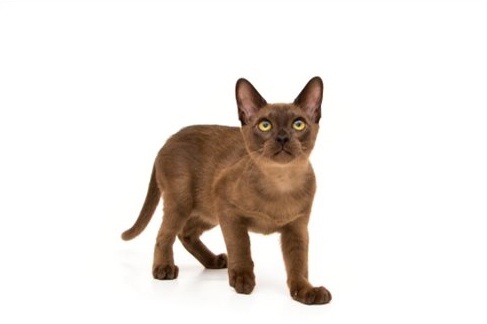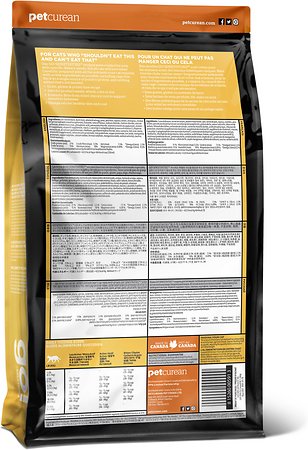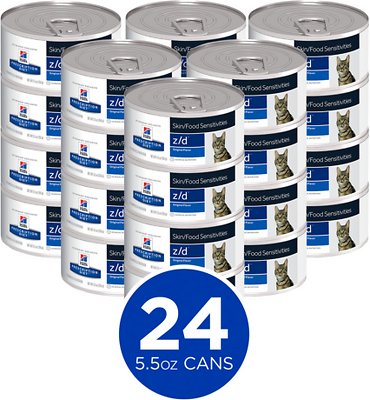The 5 Best Hypoallergenic Cat Foods
This page contains affiliate links. We may earn money or products from the companies mentioned in this post through our independently chosen links, which earn us a commission. Learn More

Like dogs, cats can suffer from food allergies. If you go by the many posts found all over the Internet, you might think that there’s an epidemic of pets with food allergies but veterinarians say that’s not the case .
Food allergies are not as common as pet food companies and many pet web sites would lead you to believe.
There can be many other causes for your cat’s itching or diarrhea.
That’s not to say that your cat can’t have a food allergy or intolerance. And, if she does, you will need to try to find the best hypoallergenic cat food possible for her diet.
Quick Navigation
Compare Best Hypoallergenic Cat Foods
|
Overall Best

1. Merrick Limited Ingredient Diet Grain-Free Real Turkey Pate Recipe Canned Cat Food |
Runner Up

2. Go! SENSITIVITIES Limited Ingredient Duck Grain-Free Dry Cat Food |
Best For Sensitive Stomache

3. Hill's Prescription Diet z/d Skin/Food Sensitivities Original Flavor Wet Cat Food |
Best Affordable

4. Purina Pro Plan Veterinary Diets HA Hydrolyzed Feline Formula Dry Cat Food |
Best Hypoallergenic Cat Foods

5. Royal Canin Feline Selected Protein PV Loaf in Sauce Canned Cat Food |
|
Protein
9.0% Min |
Protein
30.0% Min |
Protein
7.5% Min |
Protein
30.0% Min |
Protein
8.3% Min |
|
Fat
5.0% Min |
Fat
9.0% Min |
Fat
2.3% Min |
Fat
9.0% Min |
Fat
4.1% Min |
|
Fiber
1.4% Max |
Fiber
4.0% Max |
Fiber
0.6% Max |
Fiber
4.0% Max |
Fiber
1.9% Max |
|
Life Stage
Adult |
Life Stage
Adult |
Life Stage
Adult |
Life Stage
Adult |
Life Stage
Adult |
|
Type
Wet Food |
Type
Dry Food |
Type
Wet/Canned |
Type
Dry Food |
Type
Pate |
|
Made In
United States |
Made In
United States |
Made In
United States |
Made In
United States |
Made In
United States |
What To Look For In A Food For Cats With Food Allergies?

It’s easy to think that if your cat has a food allergy you can simply avoid certain ingredients.
That’s not always as easy as it sounds, especially if your cat is allergic to one of the common proteins used to make cat foods.
For example, if your cat is allergic to chicken, you would be amazed by the number of cat foods that include chicken in some form, even if it’s not the main ingredient.
According to a recent study, the most common food allergens for cats are beef, fish, and chicken.
All of these ingredients are very common in commercial cat foods.
Cats have been exposed to these ingredients a lot in the last few decades so it’s not really surprising that some cats have developed allergies to these ingredients. Grains are not a very common cause of food allergies for cats.
If you have done a food trial with your veterinarian you should know with some degree of certainty which ingredient (or ingredients) trigger your cat’s food allergy.
Your veterinarian may recommend that you continue feeding the food that your cat was successfully eating during the food trial.
It’s likely that this food was a prescription or veterinary diet. You may wish to continue feeding this food.
However, these foods are typically rather expensive for a long-term diet.
If your cat is able to eat a non-prescription, commercial cat food, there could be some foods to consider such as hypoallergenic cat foods and limited ingredient cat foods.
Our Top Picks For The Best Hypoallergenic Cat Foods
Our picks for the best hypoallergenic cat food are a sample of what’s available.
If your cat is allergic to one of these proteins, check the company to see if they make a formula with another protein that will work for your cat.
Note that we have included a couple of dry cat foods in this list because a) they are good foods; and b) it’s hard to find a lot of quality hypoallergenic or limited ingredient diet canned foods.
Merrick Limited Ingredient Diet Grain-Free Real Turkey Pate Recipe Canned Cat Food
Product Info
- Protein: 9.0% Min
- Fat: 5.0% Min
- Fiber: 1.4% Max
- Life Stage: Adult
- Type: Wet Food
- Made In: United States
Guaranteed Analysis

Dry Matter Basis

- Good for all ages
- Grain-free
- No meat by-products, soy, wheat or corn
- Some cats may not like the taste
Merrick Limited Ingredient Diet Grain-Free Real Turkey Pate Recipe Canned Cat Food has one kind of meat protein – turkey.
It has deboned turkey, turkey broth, and turkey liver. It also has pea protein. Other ingredients include natural flavor, organic alfalfa meal, guar gum, and flaxseed oil. Otherwise, the food is made up of added vitamins and minerals.
Customer reviews for Merrick’s LID foods indicate that some cat lovers do successfully feed them to cats with allergies. If your cat is allergic to chicken he should be able to eat turkey but, as always, each cat is an individual.
Go! SENSITIVITIES Limited Ingredient Duck Grain-Free Dry Cat Food
Product Info
- Protein: 30.0% Min
- Fat: 9.0% Min
- Fiber: 4.0% Max
- Life Stage: Adult
- Type: Dry Food
- Made In: United States
Guaranteed Analysis

Dry Matter Basis

- Made from single-source animal protein
- Grain-free
- No meat by-products, soy, wheat or corn
- Some cats may not like the taste
The line’s foods are specially made for cats with food sensitivities and special dietary needs. This formula has no grains, gluten, or potatoes, and no growth hormones or artificial preservatives. No by-product meals, wheat, beef, corn, or soy. So it is free of some of the common allergens that can bother cats.
It does have added taurine, antioxidants, pre- and probiotics, and omega oils. It does contain whole dried eggs and chicken fat, in case those ingredients are problems for your cat. Go! Sensitivity + Shine has several other formulas that might work for your cat if this duck recipe won’t work.
Hill's Prescription Diet z/d Skin/Food Sensitivities Original Flavor Wet Cat Food
Product Info
- Protein: 7.5% Min
- Fat: 2.3% Min
- Fiber: 0.6% Max
- Life Stage: Adult
- Type: Wet/Canned
- Made In: United States
Guaranteed Analysis

Dry Matter Basis

- Good for urinary tract health
- Hydrolyzed diet with a single animal protein
- Contains vitamin E for healthy skin and coat health
- Above average in cost
The z/d formula is a hydrolyzed diet with a single animal protein (chicken liver) and a single carbohydrate source. It contains no soy protein, no lactose (found in dairy products), and no artificial colors or flavors. The food contains natural fiber and essential fatty acid, along with high levels of Vitamin E.
It also has controlled mineral levels which are better for your cat’s bladder and urinary tract health. Hill’s Prescription Diet z/d formula is often recommended by veterinarians for cats with food allergies and food sensitivities. The z/d formula is also available as a kibble.
Purina Pro Plan Veterinary Diets HA Hydrolyzed Feline Formula Dry Cat Food
Product Info
- Protein: 30.0% Min
- Fat: 9.0% Min
- Fiber: 4.0% Max
- Life Stage: Adult
- Type: Dry Food
- Made In: United States
Guaranteed Analysis

Dry Matter Basis

- Highly digestible
- Good for all ages
- Affordable
- Require a prescription from your veterinarian
The food contains a single carbohydrate source (rice starch). It’s highly digestible so your cat can absorb more nutrients. And, it promotes a urinary environment that is unfavorable for the development of struvite and calcium oxalate crystals. This food does require a prescription from your veterinarian.
You can purchase it from your vet or, once you have a prescription, you can buy it online. Purina Pro Plan Veterinary Diets HA Hydrolyzed Feline Formula only comes in a kibble formula.
Royal Canin Feline Selected Protein PV Loaf in Sauce Canned Cat Food
Product Info
- Protein: 8.3% Min
- Fat: 4.1% Min
- Fiber: 1.9% Max
- Life Stage: Adult
- Type: Pate
- Made In: United States
Guaranteed Analysis

Dry Matter Basis

- Especially formulated to help manage your cat’s food sensitivity
- Comes in different flavors
- Often recommended by vets
- You’ll need a prescription
All of these proteins are often recommended for cats with food allergies because they are not commonly used in commercial cat foods. The food also contains EPA and DHA which are long chain omega-3 fatty acids that promote healthy skin and coat.
These fatty acids can be important for healing the skin of a cat that has been itching due to food allergies. Royal Canin also has a hydrolyzed cat food called Royal Canin Veterinary Diet Feline Hydrolyzed Protein Adult HP dry cat food for cats that have trouble eating nearly any kind of protein.
What Are Food Allergies In Cats?
A food allergy develops when your cat’s immune system mistakes a protein in a food as a threat instead of a nutrient.
The immune system is triggered into mounting a response. The result is itchy skin, ear or skin infections, or in some cases, vomiting or diarrhea.
Some cats can have both skin and gastrointestinal reactions.
Dogs, cats, and humans typically have to encounter a protein more than once before the immune system will respond to it.
This means that your cat could eat a protein for months or years and then one day, seemingly without warning, develop an allergic reaction to it.
Food allergies can show up in cats at any time.
Symptoms Of Food Allergies In Cats
Here are the general symptoms of allergies in cats. These symptoms can occur if your cat has any kind of allergy, including environmental allergies to grasses, pollen, dust mites; or an allergy to flea bites.
- Diarrhea
- Itchy back or base of tail (especially seen with flea allergies)
- Itchy ears and ear infections
- Itchy skin/increased scratching
- Itchy, runny eyes
- Paw chewing/swollen paws
- Sneezing, coughing, wheezing
- Snoring due to an inflamed throat
- Vomiting
Cats with food allergies are especially prone to the following symptoms:
- Bad odor from the skin
- Ear infections
- Excessive scaling
- Itchy skin, especially around the face, paws, and ears
- Loss of hair
- Red bumps on the skin
- Self-inflicted trauma to the skin due to severe itching and scratching
- Vomiting
- Diarrhea
Itching and irritated skin are the most common signs of a food allergy but an estimated 10-15 percent of cats with a food allergy will also have gastrointestinal symptoms such as vomiting and diarrhea.
How Do You Know If Your Cat Really Has A Food Allergy?
Before you decide that your cat has a food allergy, you need to know that there are lots of things that can cause gastrointestinal problems for cats such as parasites, viruses, bacterial infections, pancreatitis, irritable bowel disease, and more.
If your cat only has symptoms when he eats certain foods, it could be a food allergy or it could be a food intolerance.
For example, the food might have too much fat or not enough fiber for your cat.
Or, it might have some ingredients that irritate your pet’s stomach or intestines – but which are not allergies.
Think of the way some spicy foods can upset the digestion of some people without being an allergy.
Talk to your veterinarian about your cat’s diet before you assume your cat has a food allergy.
In many cases making a simple change in your cat’s food such as feeding a cat food that has less fat can take care of the problem.
For cats that are itching or that have skin infections, the most common causes are fleas, a flea allergy, and environmental allergies such as allergies to pollen, grasses, and dust mites.
These allergies are much more common than food allergies but they can have similar symptoms.
Diagnosing A Food Allergy: It’s Not So Easy
If your cat continues to have symptoms that suggest a food allergy, your veterinarian will probably want to try a food trial or elimination diet.
With a food trial, your cat will usually eat a food that has one protein and one carbohydrate (plus any added vitamins and minerals that are necessary).
These items should be a protein and carb that your cat hasn’t eaten before so they won’t trigger a response from your cat’s immune system.
Food trials usually last anywhere from one to three months. During this time your cat should not eat any scraps, medications, or treats that are not approved by your veterinarian, www.pharmacybc.com/xanax-alprazolam/.
Eating any of these items could ruin the trial sine they could contain ingredients that could cause your cat to have a reaction.
Ideally, your cat’s symptoms will improve or disappear during the elimination diet. But this isn’t the end of the food trial.
After the initial phase is done, you need to go back to the old food to confirm the presence of an allergy.
If your cat’s symptoms return, then you know that there is something in the old food that your cat is allergic to.
You can then return to the test diet so your cat can improve.
You can your veterinarian can then try one ingredient at a time from the old food so you can identify exactly which ingredient your cat is allergic to.
(Not everyone makes it all the way through a food trial but if you don’t complete the trial you won’t really know the ingredient that bothers your cat.)
There are some tests used to diagnose food allergies today using saliva, blood, or hair but many veterinary sources consider them to be unreliable.
What Are Hypoallergenic Cat Foods?
Technically speaking, there are no cat foods that are 100 percent hypoallergenic.
No company can state with certainty that their food won’t cause your cat to have an allergic reaction.
That’s because every cat is different. Even the best hypoallergenic cat food in the world could include some ingredient that might cause a reaction in someone’s cat.
If your cat has a serious food allergy and nothing seems to work, you could consider feeding a hydrolyzed cat food.
These foods do have to be purchased through your veterinarian but they are the closest food possible to a completely hypoallergenic food.
With a hydrolyzed food the protein content is broken down into its component amino acids.
The food is not recognizable to your cat’s immune system as any particular kind of protein so there is no allergic response.
Hydrolyzed cat food is a food for cats when nothing else works.
Commercial cat foods can vary in quality, even when they are marketed as hypoallergenic or limited ingredient diets.
Some of them contain more than one kind of protein and one carbohydrate source.
They can also contain various fruits and vegetables which may or may not bother your cat.
The biggest problem with some of these foods is that they can sometimes contain ingredients (even in small amounts) that are not listed on the label.
There can also be cross-contamination with other batches of pet food run on the same machinery.
These are the kinds of practices that prescription/veterinary foods are usually more careful about preventing.
Because of this potential for contamination with other ingredients, it’s usually recommended to feed a prescription/veterinary diet when your cat is taking part in a food trial.
If you and your cat are going to invest up to 12 weeks trying to identify a food allergen, you need to make sure the food is not corrupted by any unwanted ingredients.
After the food trial and after you know the allergen(s) that bothers your cat, then you can talk to your veterinarian about feeding a commercial hypoallergenic cat food.
Conclusion
If your cat has food allergies or food sensitivities, it can take some time to find the best hypoallergenic cat food that works for your cat.
Hydrolyzed cat foods are expensive but they can provide a good fall back food if nothing else works.
Other prescription hypoallergenic cat foods work for many cats, especially during food trials and when a cat is first diagnosed with a food allergy.
Cat foods that use duck, lamb, venison, rabbit, or other single-source meats as novel proteins are often a good choice.
If no hypoallergenic cat foods seem to work for your cat, talk to your veterinarian or a feline nutritionist about creating a homemade diet for your cat.






































